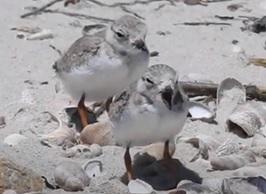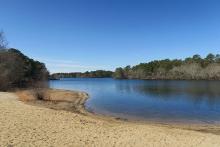Naturalist’s Corner: Piping Plovers
Posted August 5, 2020
Written by Kyla Isakson
Piping plovers (Charadrius melodus) are small shorebirds native to North America. These birds breed in the northeastern U.S. during the summer, and they migrate to the southeastern coast of the U.S. and Gulf of Mexico in the winter. Piping plovers usually change mates during the next mating season, and they feed on marine and freshwater invertebrates along the seashore.
They typically nest in soft sands away from the shore’s edge. The nest is a small indentation in the ground, and piping plovers exhibit strong site fidelity meaning they return to the same location to nest each year. Piping plovers typically lay two to four cream colored eggs, which have brown markings so they can be easily camouflaged in the sand. Both parents incubate the eggs for 26-28 days. 21 to 35 days after hatching, these birds are able to fly, and they feed themselves.
Piping plovers are threatened in the eastern U.S., and they are considered endangered in the Great Lakes Region. Their nests are susceptible to predators such as raccoons, dogs, skunks, rats, and gulls. Other threats to piping plovers include habitat destruction, water level changes, and harassment by people and vehicles. Conservation efforts include closing beaches during breeding season to reduce the risk of disturbance.















